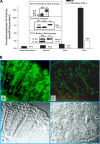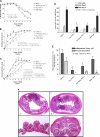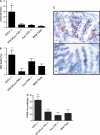Exploring the interplay of barrier function and leukocyte recruitment in intestinal inflammation by targeting fucosyltransferase VII and trefoil factor 3
- PMID: 20299601
- PMCID: PMC2904110
- DOI: 10.1152/ajpgi.00228.2009
Exploring the interplay of barrier function and leukocyte recruitment in intestinal inflammation by targeting fucosyltransferase VII and trefoil factor 3
Abstract
Intestinal mucosal integrity is dependent on epithelial function and a regulated immune response to injury. Fucosyltransferase VII (Fuc-TVII) is an essential enzyme required for the expression of the functional ligand for E- and P-selectin. Trefoil factor 3 (TFF3) is involved in both protecting the intestinal epithelium against injury as well as aiding in wound repair following injury. The aim of the present study was to assess the interplay between barrier function and leukocyte recruitment in intestinal inflammation. More specifically, we aimed to examine how targeted disruption of Fuc-TVII either in wild-type or TFF3(-/-) mice would alter their susceptibility to colonic injury. TFF3 and Fuc-TVII double-knockout mice (TFF3/Fuc-TVII(-/-) mice) were generated by mating TFF3(-/-) and Fuc-TVII(-/-) mice. Colitis was induced by administration of dextran sodium sulfate (DSS) (2.5% wt/vol) in the drinking water. Changes in baseline body weight, diarrhea, and fecal blood were assessed daily. Upon euthanasia, extents of colonic inflammation were assessed macroscopically, microscopically, and through quantification of myeloperoxidase (MPO) activity. Colonic lymphocyte subpopulations were assessed at 6 days after administration of DSS by flow cytometry and immunohistochemistry. No baseline intestinal inflammation was found in TFF3/Fuc-TVII(-/-), TFF3(-/-), Fuc-TVII(-/-), or wild-type mice. Loss of Fuc-TVII resulted in a reduction in disease severity whereas TFF3(-/-) mice were markedly more susceptible to DSS-induced colitis. Remarkably, the loss of Fuc-TVII in TFF3(-/-) mice markedly decreased the severity of DSS-induced colitis as evidenced by reduced weight loss, diarrhea, decreased colonic MPO levels and improved survival. Furthermore, the loss of TFF3 resulted in increased severity of spontaneous colitis in IL-2/beta-microglobulin-deficient mice. These studies highlight the importance of the interplay between factors involved in the innate immune response, mucosal barrier function, and genes involved in regulating leukocyte recruitment and other aspects of the immune response.
Figures





Similar articles
-
TFF2 deficiency exacerbates weight loss and alters immune cell and cytokine profiles in DSS colitis, and this cannot be rescued by wild-type bone marrow.Am J Physiol Gastrointest Liver Physiol. 2015 Jan 1;308(1):G12-24. doi: 10.1152/ajpgi.00172.2014. Epub 2014 Oct 16. Am J Physiol Gastrointest Liver Physiol. 2015. PMID: 25324506 Free PMC article.
-
Colitis-associated variant of TLR2 causes impaired mucosal repair because of TFF3 deficiency.Gastroenterology. 2009 Jul;137(1):209-20. doi: 10.1053/j.gastro.2009.03.007. Epub 2009 Mar 18. Gastroenterology. 2009. PMID: 19303021 Free PMC article.
-
Fuc-TVII is required for T helper 1 and T cytotoxic 1 lymphocyte selectin ligand expression and recruitment in inflammation, and together with Fuc-TIV regulates naive T cell trafficking to lymph nodes.J Exp Med. 2001 Sep 3;194(5):601-14. doi: 10.1084/jem.194.5.601. J Exp Med. 2001. PMID: 11535629 Free PMC article.
-
Protein kinase C iota in the intestinal epithelium protects against dextran sodium sulfate-induced colitis.Inflamm Bowel Dis. 2011 Aug;17(8):1685-97. doi: 10.1002/ibd.21547. Epub 2010 Nov 15. Inflamm Bowel Dis. 2011. PMID: 21744423 Free PMC article.
-
Time-of-Day-Dependent Trafficking and Function of Leukocyte Subsets.Trends Immunol. 2019 Jun;40(6):524-537. doi: 10.1016/j.it.2019.03.010. Epub 2019 May 17. Trends Immunol. 2019. PMID: 31109762 Review.
Cited by
-
Gut Epithelial Vitamin D Receptor Regulates Microbiota-Dependent Mucosal Inflammation by Suppressing Intestinal Epithelial Cell Apoptosis.Endocrinology. 2018 Feb 1;159(2):967-979. doi: 10.1210/en.2017-00748. Endocrinology. 2018. PMID: 29228157 Free PMC article.
-
Bifidobacterium bifidum Enhances the Intestinal Epithelial Tight Junction Barrier and Protects against Intestinal Inflammation by Targeting the Toll-like Receptor-2 Pathway in an NF-κB-Independent Manner.Int J Mol Sci. 2021 Jul 28;22(15):8070. doi: 10.3390/ijms22158070. Int J Mol Sci. 2021. PMID: 34360835 Free PMC article.
-
Renin-angiotensin system promotes colonic inflammation by inducing TH17 activation via JAK2/STAT pathway.Am J Physiol Gastrointest Liver Physiol. 2019 Jun 1;316(6):G774-G784. doi: 10.1152/ajpgi.00053.2019. Epub 2019 Apr 17. Am J Physiol Gastrointest Liver Physiol. 2019. PMID: 30995068 Free PMC article.
-
Production of Monoclonal Antibodies against Human Trefoil Factor 3 and Development of a Modified-Sandwich ELISA for Detection of Trefoil Factor 3 Homodimer in Saliva.Biol Proced Online. 2017 Nov 8;19:14. doi: 10.1186/s12575-017-0064-3. eCollection 2017. Biol Proced Online. 2017. PMID: 29151819 Free PMC article.
-
Giardia co-infection promotes the secretion of antimicrobial peptides beta-defensin 2 and trefoil factor 3 and attenuates attaching and effacing bacteria-induced intestinal disease.PLoS One. 2017 Jun 16;12(6):e0178647. doi: 10.1371/journal.pone.0178647. eCollection 2017. PLoS One. 2017. PMID: 28622393 Free PMC article.
References
-
- Andres PG, Beck PL, Mizoguchi E, Mizoguchi A, Bhan AK, Dawson T, Kuziel WA, Maeda N, MacDermott RP, Podolsky DK, Reinecker HC. Mice with a selective deletion of the CC chemokine receptors 5 or 2 are protected from dextran sodium sulfate-mediated colitis: lack of CC chemokine receptor 5 expression results in a NK1.1+ lymphocyte-associated Th2-type immune response in the intestine. J Immunol 164: 6303–6312, 2000 - PubMed
-
- Babyatsky MW, deBeaumont M, Thim L, Podolsky DK. Oral trefoil peptides protect against ethanol- and indomethacin-induced gastric injury in rats. Gastroenterology 110: 489–497, 1996 - PubMed
-
- Beck PL, Wong JF, Li Y, Swaminathan S, Xavier RJ, Devaney KL, Podolsky DK. Chemotherapy- and radiotherapy-induced intestinal damage is regulated by intestinal trefoil factor. Gastroenterology 126: 796–808, 2004 - PubMed
-
- Beck PL, Xavier R, Lu N, Nanda NN, Dinauer M, Podolsky DK, Seed B. Mechanisms of NSAID-induced gastrointestinal injury defined using mutant mice. Gastroenterology 119: 699–705, 2000 - PubMed
-
- Biol MC, Pintori S, Mathian B, Louisot P. Dietary regulation of intestinal glycosyl-transferase activities: relation between developmental changes and weaning in rats. J Nutr 121: 114–125, 1991 - PubMed
Publication types
MeSH terms
Substances
Grants and funding
LinkOut - more resources
Full Text Sources
Other Literature Sources
Molecular Biology Databases
Research Materials
Miscellaneous

